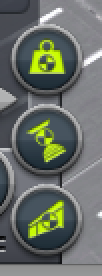Chapter 4. Planes in Space
Rockets aren’t the only way to get to space. In addition to the traditional “giant tube of explosions that flings things up high” approach, Kerbal Space Program includes a very useful piece of equipment that became quite popular in the 20th century: wings.
In this chapter, you’ll learn about the Space Plane Hangar, a building that forms part of the Kerbal Space Center complex. You’ll start by learning how to fly the built-in planes that come with the game, including taking off and safely landing. Next, you’ll learn about the principles of designing a plane, and then use them to build a plane that can not only fly, but also fly to orbit.
Heading Out for a Joyride
The best way to learn about aerodynamic flight in Kerbal Space Program is to jump into a premade airplane. Let’s get started by jumping into the Aeris-3A (see Figure 4-1), a simple little jet that’s perfect for learning to fly.
First, go to the Space Plane Hangar (SPH). The SPH is the building next to the runway. Next, load the Aeris-3A by clicking on the Load button at the top right of the screen and selecting from the list that appears. Now, launch the plane by clicking the Launch button.
You’ll now be looking at your plane on the runway. Just as in real life, to get into the air, you’ll need to fire up the engines and pull up.
There are a couple of preflight things to do before you turn on the engine. First, increase the throttle to maximum by pressing Z. Next, turn on the SAS module by pressing T.
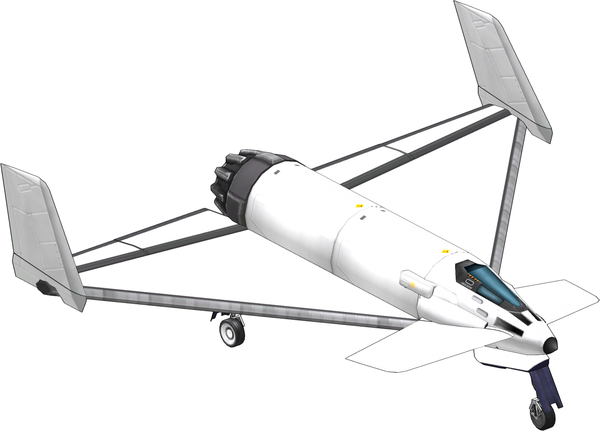
Figure 4-1. The Aeris-3A
You’re now ready. Press the space bar to fire the engines. You’ll start moving slowly at first but will pick up speed in no time at all. Keep an eye on your surface speed indicator, which is just above the navball.
When you hit about 90 m/s, pull up by holding S. Your plane will lift into the air. Once you’re off the ground, press G to retract your landing gear.
Now that you’re in the air, you can use the W, A, S, D, Q, and E keys to steer (see Figure 4-2).
Here are some tips for flight:
-
To turn the plane, it’s possible to steer by using A and D, but it’s easier to steer by banking a little with the Q and E keys, and then using W and S to pitch up and down. Your plane has a rudder, but it’s easier to steer by using the larger, more effective wings.
-
While steering, don’t turn the craft too far away from your direction of travel—that is, the prograde indicator on the navball—or your plane will encounter lots of drag and spin out. Turn slowly.
-
You don’t need to have your thrust at maximum to fly. Reduce your thrust to keep your fuel burn manageable and your craft easier to steer.
When you’re done flying around, it’s time to land (see Figure 4-3).
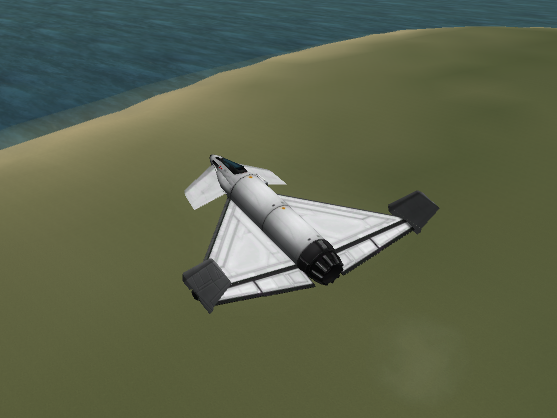
Figure 4-2. The Aeris-3A, in flight
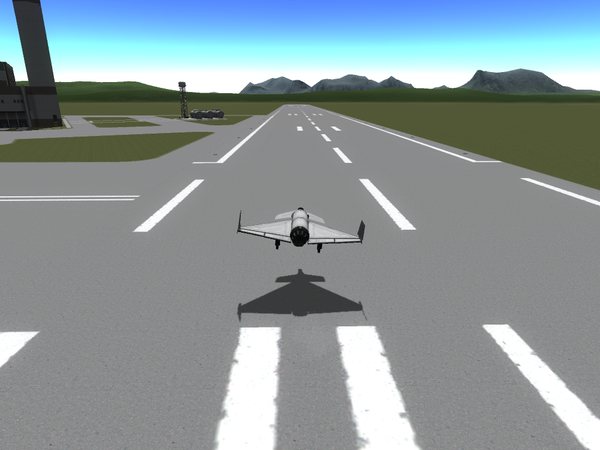
Figure 4-3. The Aeris-3A, about to land
Note
There are two places to land your plane in the immediate vicinity of the Kerbal Space Center. In addition to the airstrip that you took off from, there’s an abandoned airfield on an island a few kilometers southeast. Once you’re comfortable flying and landing at the main runway, try your hand at landing on the island. It’s more of a challenge, since the surrounding area is hilly and the runway is shorter!
The theory of safely landing a plane in the game is the same as landing a rocket: parts have a maximum safe impact speed, and some parts have a higher maximum impact speed than others. The parts that have the highest speed are the landing gear parts. This means that if you land on those parts, you’ll be fine.
To land the plane, you need to touch down on your landing gear as gently as you can. The landing gear on the Aeris-3A is the LY-10 landing gear, which has a maximum impact speed of 50 m/s.
You can control your speed both by changing your thrust and by pitching up and down. When your craft pitches upward, you lose speed but gain altitude; when you pitch downward, you lose altitude but gain speed.
Line up with the runway, and reduce your thrust. Begin to slowly lower yourself down to the ground. Remember that your ability to change your direction of travel is linked to your speed—if you’re at low speed, you can’t change direction quickly, but if you’re at high speed, you won’t survive landing.
As you approach the ground, reduce your engines and pull up slightly to drop your speed as much as possible. Your goal is to touch the ground at the gentlest speed you can.
Note
It’s OK if you can’t hit the runway. Landing on the flat grass surrounding the Kerbal Space Center is just as safe but looks a lot less cool.
Once you touch the ground, you need to reduce your speed quickly. Click the Brake button, or hold the B key. Additionally, press X to cut your engines altogether. If you landed on the runway, try to steer to keep from falling off—the steep incline that surrounds the runway can be dangerous.
Finally, you’ll come to a stop. Congratulations! You just flew a plane and survived!
Designing for Flight
Now that you’re familiar with getting around in the air, it’s important to understand how flight works in Kerbal Space Program. We’ll start with a discussion of how planes fly, and then look at the various parts that you’ll find on a plane that you often won’t find on a rocket. Finally, we’ll take a look at how to design planes so that they’ll fly well.
Aerodynamic Forces
Just as in the real world, flight is achieved as a result of multiple forces combining together. Two of these forces are things that you’ll already be familiar with from flying rockets:
-
Thrust from your engine pushes your plane forward.
-
Gravity from the planet pulls your plane down.
Two other forces become a lot more important when you’re flying planes and are a direct result of your plane traveling through air:
-
Drag, pushes back on your plane, countering your forward movement.
-
Lift, which results from your wings deflecting air downward, pushes your plane upward, countering gravity.
These forces are illustrated in Figure 4-4.
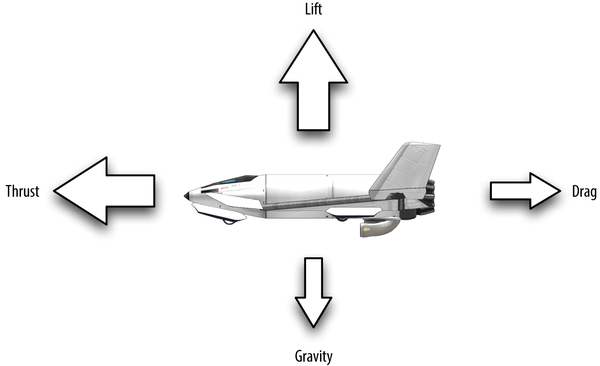
Figure 4-4. Aerodynamic forces
Because drag and lift are both consequences of traveling through air, they’re proportional to your speed. You control your speed by varying the thrust of your plane’s engines.
Note
This is why planes need a runway: until they’re traveling fast enough through the air, the wings aren’t providing enough lift to counter the force of gravity.
These principles are used by KSP, and the forces are calculated as part of the simulation. You can see the internals of KSP’s simulation by pressing the F12 key while in flight: when you do this, arrows will appear on all parts that are experiencing aerodynamic forces, which indicate the direction in which each part is being pulled. You’ll notice that your wings have a strong upward force in flight, and almost all parts are also experiencing a force that’s pushing back. That’s lift and drag!
Imagine that a plane is flying through the air, and its attitude is completely level—it’s neither pulling upward nor diving downward. Gravity is pulling it down, and its wings are pulling it up; additionally, its engines are thrusting it forward, while drag is pushing back.
Now imagine that the front of the plane is heavy. Maybe it’s carrying a large payload of cargo, or maybe the fuel tanks at the back are being drained faster than the tanks at the front (see Figure 4-5).
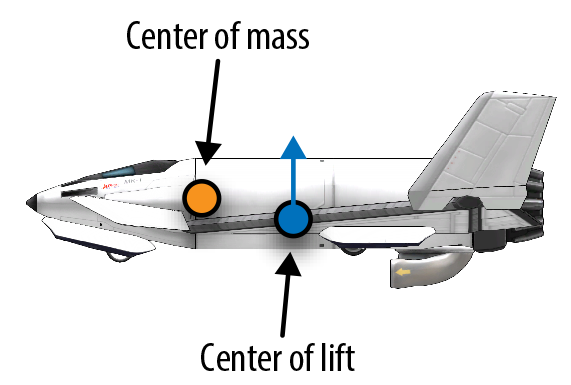
Figure 4-5. The plane, with a shifted center of mass
Because the center of gravity is far from the center of lift, the plane is now being pulled downward by gravity at a different point to where it’s being pulled upward by lift. This means that the plane will rotate.
Let’s take a different example: suppose that the engines have been mounted a little higher up than the center of gravity (see Figure 4-6).
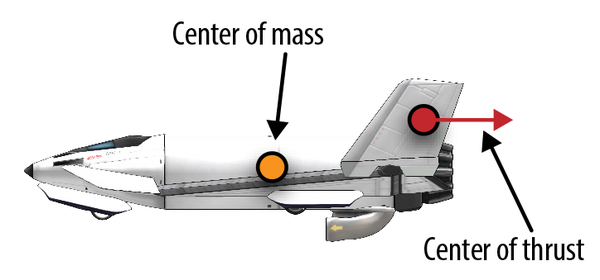
Figure 4-6. The plane, with a shifted center of thrust
This will also make the plane rotate, because the thrust isn’t going through the center of mass, which causes spin.
Through good piloting, you can deal with these centers of force being out of alignment; however, it’s a lot easier to fly a well-designed plane than it is to try to fight with a poorly designed one.
Building a Plane
There’s no special difference between planes and rockets in Kerbal Space Program—both are vessels that use engines to propel themselves forward. The only difference is that a rocket’s design is focused on getting out of the atmosphere as quickly as possible, while a plane’s design includes parts that are designed for use in atmosphere.
In this section, we’ll take a look at these plane-specific parts and discuss what they do and how they relate to other parts.
Jet engines
Jet engines are the part that is the most unique to planes. To talk about jet engines, we first need to talk about how rocket engines work.
To burn something, you (generally) need oxygen. Because there’s no oxygen in the vacuum, rocket engines combine their fuel with an oxidizer in order to burn. This is the reason why your fuel tanks are filled with an amount of liquid fuel and oxidizer, and both of them are consumed when the rocket is burning.
However, in atmospheres that contain oxygen, your oxidizer is all around you. A jet engine, therefore, is an engine that combines air with liquid fuel and emits exhaust as thrust.
Note
While many planets and moons in the solar system have an atmosphere, not all of these atmospheres have oxygen. Only your home planet of Kerbin and Jool’s moon Laythe have an oxygen-rich atmosphere, which means that jet engines will only work on these two planets. If you fly to Duna, for example, it just won’t work.
However, this doesn’t mean that you can’t use planes at all. Although jet engines won’t work, your wings will generate lift just fine. You’ll just need to use an alternative method of propulsion, like rocket engines. Alternatively, you can also use a glider.
The amount of thrust that an engine produces varies based on its speed: when stationary, a jet engine will produce low thrust, and when traveling at high speed, the engine will produce higher thrust. The specific “high speed” for an engine varies based on model.
There are six different models of jet engines, and all are good at different things.
-
The J-20 “Juno” Basic Jet Engine is the smallest of all air-breathing jet engines and is very good for low-altitude flight. The Juno produces the least thrust of all of the jet engines; its efficiency peaks at speeds of about Mach 1.25.
-
The J-33 “Wheesley” Turbofan Engine is designed for low-altitude flight and is most efficient at lower speeds and in thicker atmosphere. The Wheesley doesn’t produce a huge amount of thrust but is very fuel efficient. It produces maximum thrust at around Mach 1.6 to 1.8.
The Wheesley is good for low-altitude flight, when you know that you’ll be operating in thicker atmosphere. Use this if you just need to get from place to place on a planet.
-
The J-404 “Panther” Afterburning Turbofan is very similar to the Wheesley, but with a significant difference: it has an afterburner, which injects additional fuel at the exhaust to increase thrust. When the afterburner is used, the fuel efficiency of the engine is significantly reduced. The Panther is therefore a good choice for aircraft that will normally not need to travel at very high velocity but need the ability to increase thrust when necessary.
-
The J-X4 “Whiplash” Turbo Ramjet Engine is designed for higher-altitude flight and is most efficient at high speeds. It produces maximum thrust at about Mach 3.
The Turbo Ramjet Engine is good for high-altitude, high-speed flight. Use this to either get most of the way to orbit, or if you need to travel long distances quickly on a planet. Because all jet engines experience less thrust at higher altitudes, you’ll get the best performance out of this by accelerating as fast as you can at lower atmospheres—about 4,500 to 10,600 meters—and then climb quickly to avoid damage from atmospheric heating.
-
The J-90 “Goliath” Turbofan Engine is the largest of all of the jet engines. It provides the most thrust of all, which is excellent for planes designed to carry cargo. It works best at lower altitudes, and at lower velocities.
-
The CR-7 R.A.P.I.E.R. Engine is a special type of engine: in addition to being a jet engine, it can also switch to a “closed-cycle mode” when it runs out of intake air, and become a standard rocket that burns liquid fuel and oxidizer. When operating in jet engine mode, it produces maximum thrust at about Mach 3.75.
The R.A.P.I.E.R. engine is excellent for vehicles that need to leave the atmosphere and achieve orbit. It’s the least efficient of the three engines, but its flexibility compensates. It has a similar performance profile to the Turbo Ramjet Engine, so the same tips apply.
Air intakes
Jet engines need air to work, and air intakes are the parts that collect this air.
The amount of air that an air intake can collect depends upon the density of the atmosphere and the speed at which the air intake is traveling. This is how the Turbo Ramjet works in real life: by traveling at extremely high velocities, it’s able to function in thinner atmospheres.
As with most other parts in Kerbal Space Program, air intakes are available in both radial and inline forms. Radial parts are attached to the outside of objects, while inline parts are stacked upon other parts.
Note
If you have lots of air intakes, you can extend the operating atmosphere of your engines. Don’t go too crazy, though—“intake spamming” can result in some very ugly planes and introduces a lot of drag on the aircraft.
Landing gear
When your plane is on the ground, it’s resting upon its landing gear. Landing gear for planes is similar to the retractable legs used on rockets but has an important difference: it has wheels!
By rolling along the runway, a plane is able to pick up the speed it needs to get into the air. In addition, plane landing gear is designed to have a very high impact tolerance, which means that landing your plane is considerably safer.
Landing gear comes in a variety of sizes: small, medium, and large. In addition to the retractable landing gear, you can also get fixed landing gear, which cannot be retracted.
Most types of landing gear can be steered, much like the wheels that you use on rovers, which means that moving around on the ground is easier.
When you’re building a plane, the rearmost landing gear should be behind the center of mass. If it’s the other way around—that is, the center of mass is behind the landing gear—then your plane will tip backward onto the runway.
However, the landing gear can’t be too far back from the center of mass. If it is, the rear landing gear will be driven into the ground when you try to rotate the plane on takeoff.
Your landing gear should also not be too close together. If all of the wheels are grouped together, then your plane will be very unstable on takeoff. It’s no fun to tilt over to the side and lose a wing.
Wings
Wings, as you might imagine, are important for planes. A wing’s purpose is to generate lift by deflecting air; the bigger the wing, the more air it can deflect, and the more lift it can generate.
There are different types of wings; most of the differences are in size and shape, so that you can create a design that suits your artistic vision (and aerodynamic requirements). Some wings are large enough to contain their own fuel tanks, just as in real life; using these wings means you can save space that would have otherwise been used by fuel tanks.
Control surfaces
A control surface is a movable part of a wing that allows you to control the flow of air over the vessel. Examples of control surfaces include ailerons, which allow the craft to bank; elevators, which allow the plane to pitch up and down; and rudders, which allow the plane to yaw.
In addition, you can also add airbrakes (also called spoilers), which disrupt the flow of air and significantly increase drag, which you can use to reduce your airspeed. These surfaces are bound to the B key, which means that you can use the same key to slow down while in atmosphere as you use to slow down on the ground.
Note
In real planes, control surfaces are generally built into the wings themselves, but in Kerbal Space Program you’ll need to attach these to your wings manually.
Designing Good Planes
There are two important lessons we need to keep in mind when designing planes for maximum stability:
-
The center of lift needs to be as close to the center of mass as possible.
-
The direction of the thrust needs to go through the center of mass.
You can experiment with these forces by modifying the Aeris-3A craft.
Go to the Space Plane Hangar, and load the Aeris-3A craft. Once you’re there, rename the craft to Aeris-3B, so that you don’t end up confusing yourself later.
The SPH is designed for creating horizontal vehicles, while the Vehicle Assembly Building is designed for creating vertical ones. This means that the hangar is a little different:
-
When you add a new part to your craft, it will appear lying down.
-
By default, the Symmetry mode is set to Mirror, as opposed to Radial.
To visualize the centers of mass, lift, and thrust, click on all three of the center of force buttons, which you’ll find near the bottom right of the screen (see Figure 4-7).
When you click each button, the corresponding center of force will appear. When all three are turned on, you’ll see something like Figure 4-8.
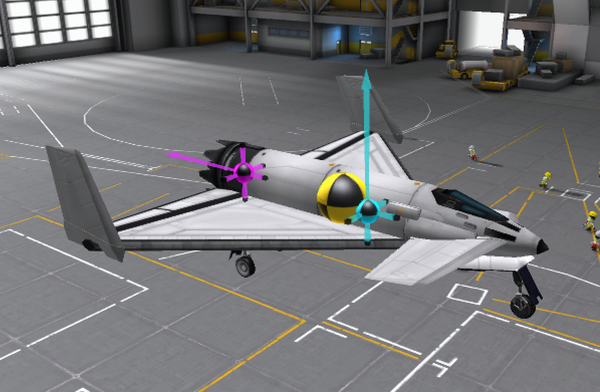
Figure 4-8. The Aeris-3B, with all three centers of force displayed
Optimizing the Center of Lift
Looking at the centers of force for the Aeris-3B, you’ll see that the center of lift is ahead of the center of gravity by a little, because of the position and angle of the canards (the little wings attached to the nose). This means that the craft will tend to want to pull up on its own.
Remove the forward canards on the nose. When you do, you’ll notice that the center of lift moves backward quite a bit. Additionally, the center of mass will move slightly back.
Note
Another source of lift, besides wings, is control surfaces. As we mentioned earlier, these are the tilting mechanisms at the back that give you control in the air.
Fly the new craft, and see how it feels compared to the original Aeris-3A.
Note
When a plane is in flight, the engines are burning fuel, which is drawn from the fuel tanks. By default, jet engines are set up to draw from all fuel tanks on the craft evenly; however, there are some conditions that can cause fuel to be drained unevenly.
If this happens, the change in distribution of weight will mean that the center of mass changes. As we discussed earlier, the position of the center of mass is a very important element in keeping your craft stable.
Keep an eye on the levels in each of your fuel tanks as you fly!
NiftyPlane 9000
Now that you’ve flown a plane, and know what it takes to get and keep a plane in the air, we’ll take the challenge level up a notch by designing and flying a single-stage-to-orbit (SSTO) craft.
An SSTO plane is a vehicle that can get from the ground to orbit in a single piece. This means that the vehicle doesn’t shed weight by detaching pieces of itself as it climbs.
SSTO planes do this by taking advantage of the lift provided by their wings, and by using fuel-efficient jet engines in atmosphere for as long as possible, until the lack of atmosphere at high altitudes forces them to use rockets. In early versions of Kerbal Space Program, the only way to build SSTO planes was to bring both jet engines and rocket engines; however, with the introduction of the dual-use R.A.P.I.E.R. engine, you can save a lot of weight and space.
The SSTO plane in this chapter, the NiftyPlane 9000, is an SSTO that can carry two Kerbals plus a small amount of cargo up to orbit. Let’s build it and then fly it!
Design
The fuselage of the plane uses Mk2 parts. The cross-section of Mk2 parts is short and wide, which both looks cool and is also large enough for you to do useful work with.
This plane is larger and heavier than the Aeris-3A, which means that flying it requires a little more care. The plane uses two R.A.P.I.E.R. engines and requires a large amount of fuel to lift the whole thing into the air.
The R.A.P.I.E.R. engine is the best engine for most SSTO craft, due to the fact that it can switch between an air-breathing jet engine mode and closed-cycle rocket engine mode. This allows you to still operate your engine in a total vacuum.
Note
When building space planes, you can easily forget that wings can’t provide directional control when they’re not in atmosphere. You need reaction wheels or RCS jets to turn your craft, so either bring some or use a part that already contains them. In the case of the NiftyPlane 9000, the cockpit part contains reaction wheels; in your own designs, you might need to add them yourself.
You can see a blueprint for the NiftyPlane 9000 in Figure 4-9.
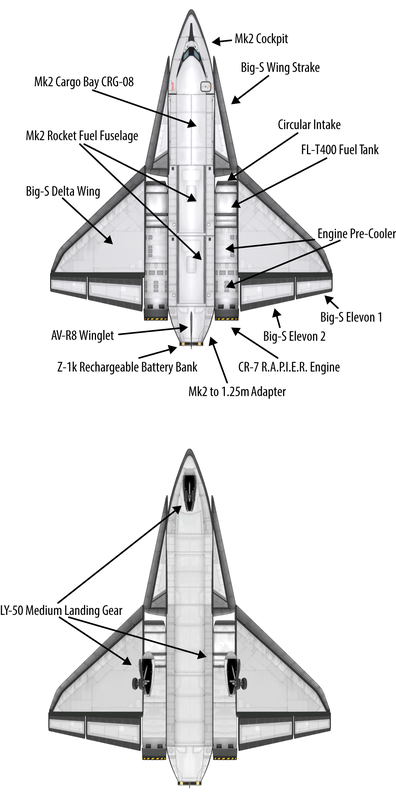
Figure 4-9. The NiftyPlane 9000
We’ve provided the list of parts, and their position in the design, in Figure 4-9. Go to the SPH, and construct the plane as shown.
Leave the settings for each of the parts as the default, with one exception: right-click on the Big-S Delta Wing, and increase the amount of fuel contained in it from 0 to its maximum of 300.
Once you’ve constructed the craft, it’s useful to add an action group that performs a number of tasks when you want to switch from air-breathing operation to closed-cycle operation. In addition to switching the operation mode of the two engines, you’ll also want to close all of your air intakes; doing this reduces the drag of your draft very slightly and improves your performance.
To add the action group, follow these steps:
-
Click on the Action Groups button at the top left of the window (see Figure 4-10).

Figure 4-10. The Action Groups button, in the center
-
Click on the Custom01 action group. This action group is run when you press the 1 key in-game.
-
Select one of the Engine Precoolers. A list of possible actions will appear; the Engine Precooler only has a single action, Toggle Intake.
Don’t forget that these parts are in pairs. If you select a part on the left, you’re also working with the part on the right.
-
Click Toggle Intake to add the action to the action group.
-
Repeat this process for the other Engine Precoolers and for the Circular Intake.
-
Select the R.A.P.I.E.R. engine, and add the Switch Mode action to the action group.
You’re done! When you’re ready to cut over to rocket mode, just press the 1 key to simultaneously close all intakes and to switch the engine’s mode.
Taking It to Orbit
Getting into orbit means achieving both high lateral velocity and high altitude. You first want to get as much speed and altitude as you can using air-breathing engines and wings, which means you want to get lots of sideways velocity and don’t need to prioritize upward velocity.
To orbit at 70 km, you need to be traveling at 2,295 m/s and be 70 km above the ground. The most important element of this is to be above the atmosphere, since drag will reduce your speed. You need to develop this speed, and also have a trajectory that will get you to that altitude, if you want to achieve an orbit.
Warning
The danger of traveling at high velocity in atmosphere is atmospheric heating. When you’re reentering an atmosphere from orbit, the compression experienced by the air you’re hitting results in severe rises in temperature. This can destroy your craft! Keep an eye on your temperature, and keep your throttle low if you start to see flames.
When you’re traveling laterally—that is, at a mostly level pitch—then you can rely on the lift generated by your wings to keep you in the air. This means that the thrust from your engines is focused on increasing your overall velocity.
By contrast, if you’re traveling upward, or even mostly upward, your thrust is being used to counteract gravity. This means that while your altitude will be increasing, your total velocity won’t increase at anywhere near the rate you need if you want to achieve orbit.
By using the R.A.P.I.E.R. engine’s jet engine mode at lower altitudes, you can develop a big chunk of your lateral velocity before climbing to higher altitude. As you climb, your engines will run out of intake air and will eventually cut over to rocket mode; once this happens, you will begin burning fuel much more rapidly and will need to escape the atmosphere as fast as possible to improve the efficiency of the rocket.
The rapier engine’s thrust is highest when it’s traveling at about Mach 3—which is about 950 m/s. If you aim straight upward, you won’t develop the speeds you need to get the most thrust out of the engine.
This means that you need to stay mostly level and get your velocity up; once you hit Mach 3, pitch up to about 50 degrees, and continue until the engines start to run low on air (you’ll notice because their exhaust plumes start to die down, along with the engine noise), press the 1 key to switch to closed-cycle mode and to close your now-unnecessary intakes, and boost to increase your apoapsis (see Figure 4-11).
Warning
When pitching up, remember to do it slowly. Sudden changes in your angle of attack can rip your plane apart!
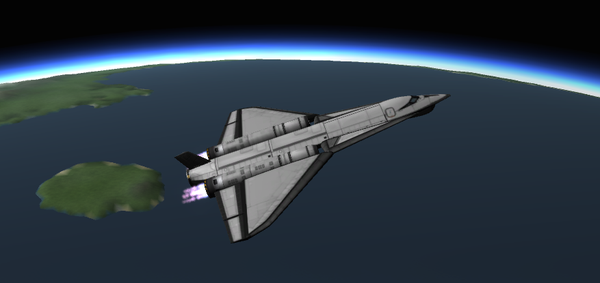
Figure 4-11. The NiftyPlane 9000 burning to reach orbit
Once your apoapsis reaches about 75 km, cut your engines and coast, and perform an orbital insertion burn at apoapsis to circularize. Congratulations! You’ve slipped the surly bonds of Earth, and you haven’t left any part of your craft behind.
Summary
In this chapter, we’ve discussed how you can design and fly planes for atmospheric flight in Kerbal Space Program. Planes can play an extremely useful role in your space program; even simply adding wings to spacecraft can make your life significantly easier when you are gliding around a planet with atmospheres, looking for a good place to land.
In the next chapter, we’ll take a look at the world—and worlds—of Kerbal Space Program.
Get The Kerbal Player's Guide now with the O’Reilly learning platform.
O’Reilly members experience books, live events, courses curated by job role, and more from O’Reilly and nearly 200 top publishers.
